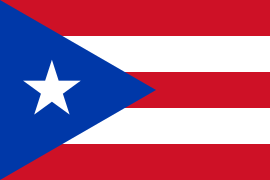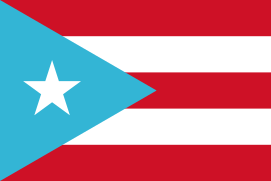Puerto Rico's flag
The flag of Puerto Rico is rectangular in shape and consists of five horizontal stripes, three red and two white. On the shaft side, it has a blue equilateral triangle with a lone white star in the center.
The flag was designed during the last decade of the 19th century as an insignia for Puerto Rican separatists residing in New York. The identity of the author of the design has been the subject of a heated debate, mentioning among its possible authors the Puerto Rican nationalists Juan de Mata Terreforte, Antonio Vélez Alvarado, Manuel Besosa and the guerrilla poet Francisco Gonzalo (Pachín) Marín. However, a letter dated May 20, 1923, written by Terreforte, establishes that it was Pachín Marín who proposed to Terreforte, in a letter from Jamaica, the design of the flag and that the latter transmitted that proposal in "Chimney Hall", where it was adopted.
The flag symbolizes the "brotherhood" in the revolutionary struggle between the Cuban and Puerto Rican separatist groups, due to the fact that the group of Puerto Rican separatists who adopted the flag design as their group's emblem, the Puerto Rico Section, was associated with the Cuban separatists who they fought with identical ideals under the Cuban Revolutionary Party. the Province of Puerto Rico became an autonomous province of the Kingdom of Spain.[citation required]
During Spanish rule as well as early American rule, it was considered a crime to fly the separatist flag. It was not until 1952 when the Nationalist Party, the same independence group, welcomed it as its emblem in the 1932 elections. Blanca Canales proclaimed the "Republic of Puerto Rico" during the Grito de Jayuya in 1950 using this separatist flag and Lolita Lebrón deployed it during the attack on Congress in 1954. In the years 1916, 1922, 1927 and 1932 the legislative chambers tried to make the flag official without success.
The separatist flag was officially adopted by the Commonwealth in 1952.
Flag Colors
The only legal references to the colors of the flag are found in the Act of July 24, 1952 and in the Regulations on the Use of the Flag of the Free State in Puerto Rico Associate from Puerto Rico:
Section 1. The flag of the Commonwealth of Puerto Rico will traditionally be known as the Puerto Rican flag and which is rectangular, of five alternating horizontal stripes, three red and two white and next to the top a sea blue equilateral triangle with a white star of five points. This triangle, on the vertical side, covers the entire width of the flag.Act of 24 July 1952
Article 3. B. The flag of the Puerto Rico Commonwealth is the one traditionally known as the Puerto Rican flag. Its shape is rectangular, with horizontal stripes, alternating, three red and two white, and it has a blue equilateral triangle with a white five-pointed star. This triangle, on the vertical side, covers the entire width of the flag.Puerto Rico Use Regulations of the Puerto Rico Commonwealth Flag
Both documents describe the flag in a very similar way, but since there are no technical specifications written, there is some confusion when it comes to choosing the tones for the colors, especially in the case of blue.
Since it was approved in 1952, the triangle was made with a dark blue very similar to that of the United States flag. But since 1995, lighter shades of blue have been used. This change, as it is not stipulated in any law, still does not resolve possible doubts about the colors. Thus, for example, the blue of the flag raised at the 2008 Beijing Olympics was dark.
Black and white variant of the flag
The curious combination of colors for the flag arose from an alteration of the flag gate located on San José street, in old San Juan.
Traditionally, the gate was painted in red and white vertical stripes with a blue triangle at the top with a white star, similar to the state flag, however on July 5, 2016 the famous tourist site suffered a change in colors made by the group Artistas Solidarixs y en Resistencia.
According to an open letter from the artists who made the change, the color change symbolizes that the flag is mourning due to the Puerto Rico Supervision, Administration and Economic Stability Act (or law PROMESA for its acronym in English) that imposes a fiscal control board and therefore, limits the political autonomy of the island in addition to severely restricting the budget in the health, pensions and education sectors.
The monochrome version of the flag has been used in multiple protest acts (such as the 2019 protests) and in urban art spaces where the change of colors has even been extended to historical versions of the flag such as the Cry of Lares.
Meaning
The red stripes represent the blood spilled by the patriots of the revolution, white ones mean victory and the coming peace, the blue equilateral triangle is a symbol of the sea and the sky of Puerto Rico, and the lone star represents the island.
According to official sources, the star is a "symbol of the Commonwealth and rests on a blue triangle that in its three angles evokes the integrity of the republican form of government represented by three branches: the legislative, the executive and the judicial". The three red stripes "symbolize the lifeblood that nourishes these three powers of local government", which perform independent and separate functions. The freedom of the individual and the rights of man keep the powers in balance and their essential mission is represented by "two white stripes".
The separatist group and historical national identity flags
The Grito de Lares flag was designed by Ramón Emeterio Betances. The flag is similar to the flag of the Dominican Republic, since the Restoration Gesta, which in 1865 definitively ended Spanish colonial rule in Santo Domingo, was one of the motivators of the Borinqueños patriots. The flag embroidered by Mariana Bracetti, known as the "Brazo de Oro" it was displayed on the main altar of the church as a sign that the revolution had begun. The flag was adopted in 1952 as the official symbol of the municipality of Lares. The original flag is preserved in the Museum of the University of Puerto Rico.
Flags of the municipalities
Contenido relacionado
Monarchy in Canada
Galician nationalism
Governor General of Canada
















